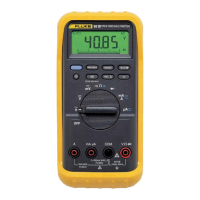80 Series III
Users Manual
16
Measuring Resistance
Caution
To avoid possible damage to the meter or to
the equipment under test, disconnect circuit
power and discharge all high-voltage
capacitors before measuring resistance.
Resistance is an opposition to current flow. The unit of
resistance is the ohm (Ω). The meter measures resistance
by sending a small current through the circuit. Because
this current flows through all possible paths between the
probes, the resistance reading represents the total
resistance of all paths between the probes.
The meter’s resistance ranges are 400 Ω, 4 kΩ, 40 kΩ,
400 kΩ, 4 MΩ, and 40 MΩ.
To measure resistance, set up the meter as shown in
Figure 4.
The following are some tips for measuring resistance:
• Because the meter’s test current flows through all
possible paths between the probe tips, the measured
value of a resistor in a circuit is often different from
the resistor’s rated value.
• The test leads can add 0.1 Ω to 0.2 Ω of error to
resistance measurements. To test the leads, touch
the probe tips together and read the resistance of the
leads. If necessary, you can use the relative (REL)
mode to automatically subtract this value.
• The resistance function can produce enough voltage
to forward-bias silicon diode or transistor junctions,
causing them to conduct. To avoid this, do not use
the 40 MΩ range for in-circuit resistance
measurements.

